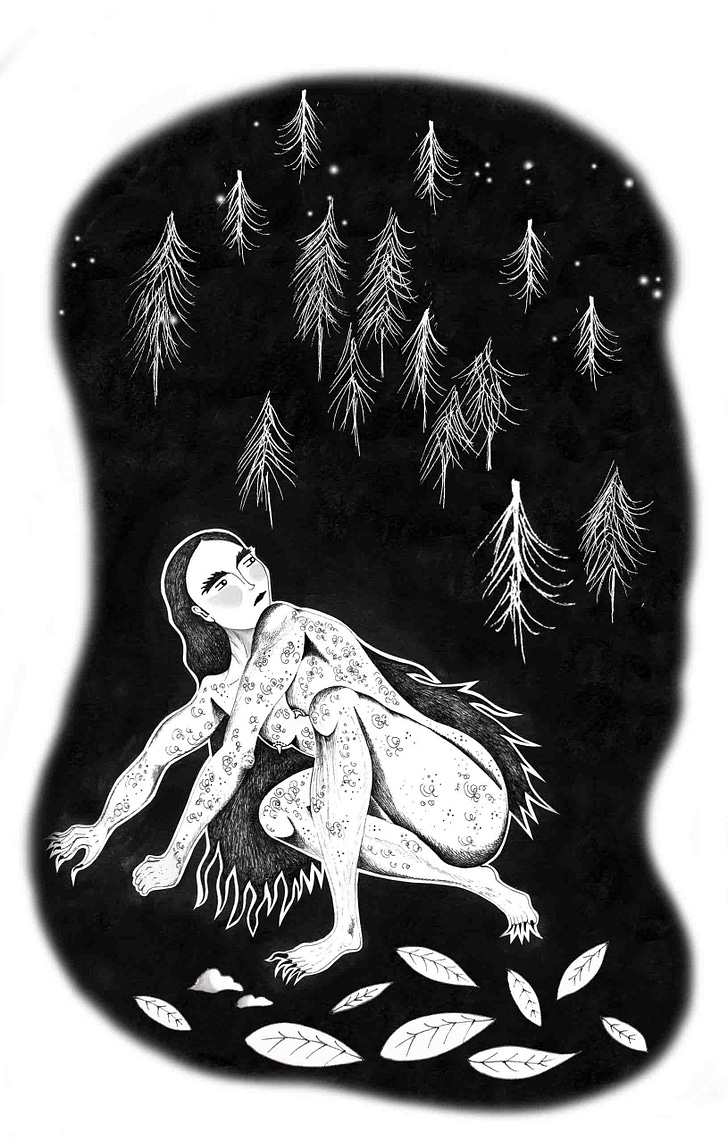Hi everyone
For this fairy tale salon, I want to stick with the theme of shapeshifting that was part of the last one (on te Fairy Mélusine) before moving on to new images and themes in stories to come.
Several years ago, while deeply entangled in selkie stories, I was researching other stories in which women had their skin (or something representing it) stolen by a man. I found mermaid stories, swan stories – and then I hit the jackpot: a Croatian story about a wolf-woman whose skin is stolen by a hunter. As a lover of all things wolf, this was my dream story. I reimagined it in Foxfire, Wolfskin, in one of my favourite stories from that collection.
So in this fairy tale salon I offer you three stories: the original, ‘Wolfskin’, my reimagining, and a wonderful original story from Ursula Le Guin which explores the same themes – but, in characteristic style, subverts them beautifully. You can listen to these three stories in the audio file below. And then let’s talk about the stories. But first: a few thoughts on the Wild Woman archetype:

Helen Nicholson’s beautiful image of Mis, for Foxfire, Wolfskin and Other Stories of Shapeshifting Women, by Sharon Blackie. Find out more about Helen here.
The Wild Woman archetype
I wrote about the Wild Woman archetype in If Women Rose Rooted, particularly in the context of the old Irish story of Mis (pronounced ‘Mish’). Mis was the daughter of Dáire Dóidgheal (pronounced Darragh Doyle), a powerful ruler from Europe who set out to invade Ireland. He landed with a huge army in Ventry, County Kerry, and a fierce battle followed which lasted a year and a day. Dáire was eventually slain by the hero-warrior Fionn mac Cumaill (pronounced Fin Mac Cool), which ended the battle.
Mis came down in the aftermath to look for her father, and found only his dead body, bleeding, on the beach. Mis was overwhelmed by grief, and flung herself across her father’s body, licking and sucking at his bloody wounds to try to heal them, just as an animal might. When this failed to restore him to life, madness overcame her and she rose up into the air like a bird and flew away into the heart of the Sliabh Mis (pronounced Sleeve Mis) mountains. She lived there for many years, and grew long trailing fur and feathers to cover her naked skin. She grew great sharp claws with which she attacked and tore to pieces any creature or person she met. She could run like the wind, and no living thing was safe from her. They thought her so dangerous that the people of Kerry created a desert stripped of people and cattle between themselves and the mountains, just for fear of her.
The king in those parts offered a reward to anyone who would capture Mis alive. No-one accepted, for fear of Mis, except for a gentle harper by the name of Dubh Ruis (pronounced Dove Rush). Dubh Ruis enticed Mis out of hiding, and made love to her. He coaxed her into a pool and, over a period of days, washed away the dirt and scrubbed away her feathers and fur. He combed her hair, and fed her, and made a bed for her. And eventually, he brought her back to civilisation, and married her.
This is some of what I wrote about Mis in If Women Rose Rooted:
Sometimes, madness seems like the only possible response to the insanity of the civilised world; sometimes, holding ourselves together is not an option, and the only way forwards is to allow ourselves to fall apart. As the story of Mis shows, that madness can represent an extreme form of initiation, a trigger for profound transformation.
… Mis is the original wild woman, that archetypal madwoman who lives deep within each of us. She speaks for us all: for the rage which we cannot express, for the grief which eats our heart out, for the voices we have suppressed out of fear. This old story shows us a brutal descent into darkness during which all illusions are stripped away and old belief systems evaporate, and in doing so it suggests that the extremities of madness or mental breakdown, with their prolonged, out-of-control descent into the unknown, might offer us a path through which we can come to terms with the truth. Like other legendary geilta (the Irish word for madwomen) Mis is driven to extremity in her grief, shape-shifting into bird form, flying away into the hills and woods, growing fur and feathers, eating wild and raw food, leaving the intolerable world behind her. But a geilt cannot emerge from her madness and come back to the world until she has achieved some kind of personal transformation. Through her ordeal – her removal from society and her time spent in the wilderness – she must find a way to reclaim a more authentic sense of identity and belonging.
Although Mis flies through the air like a bird and grows feathers as well as fur, her behaviour is decidedly wolf-like. It seems to me, then, that the positive side of the Wild Woman archetype relates to instinctual, intuitive, imaginative, creative ways knowing: an earth-based wisdom, and a sense of kinship with the rest of the natural world.



